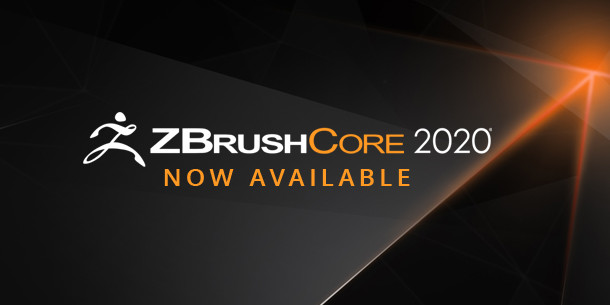Pixologic releases ZBrushCore 2020

Pixologic has released ZBrushCore 2020, the latest version of its cut-down edition of ZBrush targeted at hobbyists, students, 3D printing enthusiasts and illustrators.
The first major update to ZBrushCore since 2018, the release adds some of ZBrush’s key recent features, including dynamic tessellation system Sculptris Pro, support for SubTool folders and the Universal Camera.
As with recent updates to ZBrush itself, the update is free to existing users.
A cut-down version of ZBrush aimed at less demanding jobs
First released in 2016, ZBrushCore is a cut-down version of Pixologic’s digital sculpting software.
Users get 36 of ZBrush’s 300-odd sculpting brushes plus support for InsertMultiMesh, and basic rendering options, either via BPR or a separate paid add-on for KeyShot.
Options for painting, masking or polygrouping models are basic, and there is no support for most of ZBrush’s advanced features, including its automatic retopology, hard-surface modelling and Live Booleans toolsets.
Scripts, plugins and macros are also disabled.
New in ZBrushCore 2020: true clay-like sculpting with Sculptris Pro
ZBrushCore 2020 introduces some of the key features rolled out in the full software in recent updates, including one particularly long-awaited addition: Sculptris Pro.
First released in ZBrush 2018, the ‘dynamic tessellation’ system changes the polygon density of a mesh adaptively as an artist sculpts, rather than requiring them to subdivide it in order to carry on adding detail.
Unlike the existing DynaMesh system, it isn’t designed simply for roughing out a model: it should enable users to create detailed finished sculpts from simple primitives without having to retopologise the mesh.
Utility features: new SubTool folders and the Universal Camera
ZBrushCore users also now get SubTool folders and the Universal Camera, both added in ZBrush 2019.
The former – another long-awaited addition – makes it possible to group SubTools into folders, in turn making it possible to move, scale or duplicate entire chunks of a model in one go.
The latter replicates real-world camera properties like focal length and field of view, making it easier to match 3D models created in ZBrush to photographic backplates.
Camera settings can be exported directly to KeyShot, ZBrush’s de facto third-party renderer; and to other DCC applications via the FBX ImportExport plugin.
It is also possible to set up and save multiple camera views for a project.
New Silhouette view and CamView widget
The features ported over from ZBrush 2020, the most recent update, aren’t as major, but users to get the Mudbox-style silhouette view, intended to help check whether a model ‘reads’ correctly from its background.
The update also adds CamView, the Autodesk-style viewport widget that shows a model’s orientation in XYZ space, and which can be used to switch between camera views.
ZBrushCore users also now get ZeeZoo, ZBrush’s library of readymade ZSphere armatures, intended as a starting point when sculpting a range of creatures.
Pricing and availability
ZBrushCore 2020 is available for 64-bit Windows 7+ and 64-bit Mac OS X 10.10+. The update is free to existing users; new licences of the software now cost $179.95, up $30 on the previous release.
Pixologic has also now introduced rental-only subscriptions to ZBrushCore which cost $9.95/month.
Read a full list of new features in ZBrushCore 2020 in the online documentation
See a feature comparison table for ZBrushCore 2020 and ZBrush 2020 on the product website
